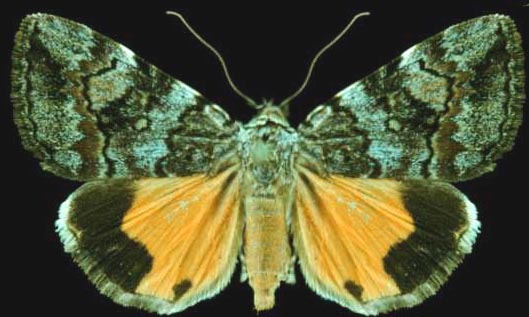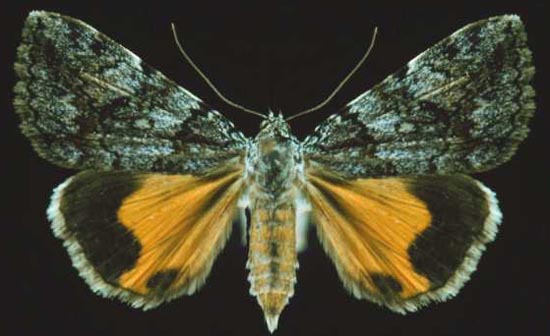Catocala jair
Catocala jair
kah-TOCK-uh-lah mm
JAY-ihr
Strecker, 1897

Catocala jair (Florida) by Harold J. Vermes.
This site has been created by
Bill Oehlke at oehlkew@islandtelecom.com
Comments, suggestions and/or additional information are welcomed by Bill.
| TAXONOMY:
Superfamily: Noctuoidea
Family: Noctuidae
Group: Noctuinina
Subfamily: Catocalinae
Genus: Catocala, Schrank, 1802
| |
MIDI MUSIC
"Moon River"
copyright C. Odenkirk
MIDI CITYON.OFF
<bgsound src="moon.mid" LOOP=FOREVER>
|
DISTRIBUTION:
Catocala jair, the Jair
Underwing (wingspan: 35-40mm), flies in southern New York, the Pine Barrens of
New Jersey, in the coastal plain in Bladen County,
North Carolina
and in the northern half of Florida. Jeffrey R. Slotten
has also recorded jair in Concan, Texas, May 21, 1995.
The moth is hard to distinguish from amica, but jair has broader,
blunter forewings than amica and the post medial line of
jair is
straighter (much less dentate) than that of amica. The
hindwings of both species seem identical.
Including two subspecies it is also found in
Alabama,
Arkansas,
Georgia,
Louisiana,
Mississippi,
Oklahoma and
Tennessee.
There is a melanistic subspecies/form from
New Jersey and New York.
FLIGHT TIMES AND PREFERRED FOOD PLANTS:
Catocala jair are usually on the wing from May to
June.
The Catocala jair caterpillar feeds on oaks.

Catocala jair (New Jersey) by Harold J. Vermes.
ECLOSION:
Adults eclose from pupae at soil surface.
SCENTING AND MATING:
Catocala jair females
emit an airbourne pheromone and males use their antennae to track the
scent plume.
EGGS, CATERPILLARS, COCOONS, AND PUPAE:
Eggs are deposited on
tree bark in the fall and hatch the following spring.
Larval Food Plants
Listed below are primary food plant(s) and alternate food plants.
It is hoped that this alphabetical listing followed by the common
name of the foodplant will prove useful. The list is not exhaustive,
although some species seem very host specific.
Experimenting with closely related foodplants is worthwhile.
This page is brought to you by Bill Oehlke and the
WLSS. Pages are on space rented from Bizland. If you would like to become a "Patron of the Sphingidae/Catocala Sites",
contact Bill.
Please send sightings/images to Bill. I will do my best to respond to requests for identification help.
Enjoy one of nature's wonderments: Live Saturniidae (Giant Silkmoth) cocoons.

|

To show appreciation for this site, click on the flashing
butterfly to the left, a link
to many worldwide insect sites. |
Return to Canadian Index
Return to Main Index



